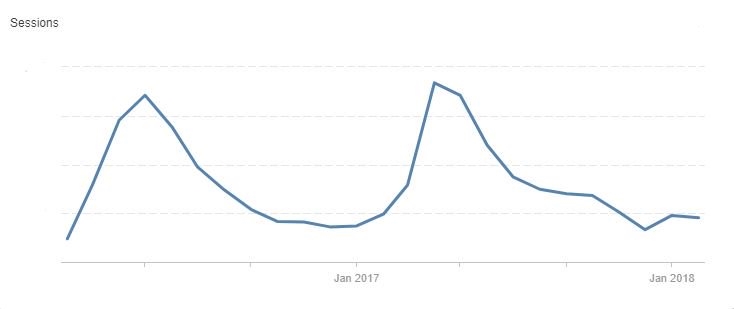— March 13, 2018
Just when we thought spring was in the air, Mother Nature sent more snow our way. Take this time to snuggle up at your desk and plan ahead for the busy spring and summer months ahead.
When it comes to online marketing, planning ahead is imperative to ensuring you run a successful and effective campaign (whether it be SEO, paid ads, social media, email, etc).
Get your marketing plan set for 2018. Check out my 5 tips below to making sure you’re set this year:
1. Determine Your Peak Season
If you don’t have Google Analytics on your site, add it there ASAP. The data provided by this free tool is imperative when figuring out when your peak season is and when to plan for lulls. No matter the seasonality of your business, there will be busy times of year. Take a look at your year over year historical data to determine which times are your busiest and when are your slowest. If you offer services year round, consider when you should use paid advertising to increase traffic and leads or when your organic search traffic and referrals will bring you enough business to keep you busy.

Don’t have this data to see when you’re swamped or slow? Check out Google Trends. From here you can see the seasonality for keyword searches specific to your industry.

The advantage of checking your peak season is that it helps you plan your budget for paid advertising, and also plan ahead promotions (ie. landscaping gets search more in May so we should focus blogging and paid efforts on that in those months).
Check your website data, there may be certain topics and pages that are more popular in particular months. All of this information can help you map out your PPC and SEO efforts.
2. Set Your Paid Advertising Budget
Set your marketing budget for the year but also plan any promotions. Will you run deals on services based on seasonality? This should all be planned in advance so you can adjust your efforts and spend throughout the season on the fly with a plan in mind. Use step one to help determine these promotions (ie. Interlock promo in June since the service is more popular in that time).
Keep your margins and return in mind. If there are certain products are services that help your business grow (good ROI), then invest time in improving your presence for that.
3. Pick Your SEO Keywords
Whether you are bidding on them for an AdWords campaign or working to show up at the top organically, it’s important to set your sites on what keywords you’d like to rank at the top for. Check your keywords for search volume – you can use the Google Keyword Planner Tool, Google Trends, Ubersuggest or your favourite keyword research tool.
Looking at search volume validates that you are going to get an increase in traffic (and hopefully leads) for that term. Don’t be overwhelmed about the actual number of searches For example – I keyword like swimming pool gets 27,000 searches/month in Canada – but this is a very general term. Someone searching swimming pool could be looking for many different services, products, information, and offerings that may not be relevant to your business. All to say, the ROI doesn’t exist when you rank at the top for that term.
Swimming pool installation companies get’s 10 searches/month. Even though the search volume is much lower, traffic coming to your site from this keyword is likely to convert to business for you. This means there is more value and return to rank at the top.
4. Analyze Your Competitors
Check out your competitors sites – search keywords in Google and see what ads come up. You can check their ad copy (if they are running AdWords campaigns) and check their websites.
The purpose of manually looking at competitors websites is auditing the amount of content they have (should you write more on your own site). But also to check usability (is their site brand new? How old is your site?). Making note of these things can help you plan if you will need additional website work or content before busy season commence.
The website that is easiest to navigate and provides the most value to traffic is going to get the most business from digital marketing. Auditing your competition can identify these changes can ensure you have a successful season.
5. Get Started
There is no time like the present! Map out your plan for the season and get implementing. If it’s not your busy season yet, then work on your SEO.
SEO is a year-round effort in order to stake your claim in the number one spot in Google. Since it is a long-term process, it is essential to constantly make SEO improvements on your site and keep and eye on results.
SEO can help raise your businesses bottom line and ensure your entire spring/summer season is booked before the snow leaves us.
BONUS: Questions to Keep In Mind
- What is my annual marketing budget?
- When are my busiest times? Do I need to supplement slow times with more leads?
- What services would I like to promote most?
- What kind of promotions do I want to run and when?
- Who are my main competitors and what are they doing for online marketing? (check website, social media profiles, etc.)
- How am I going to implement this strategy this year?
Digital & Social Articles on Business 2 Community
(54)
Report Post





